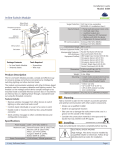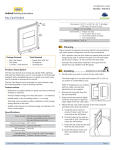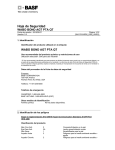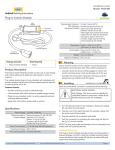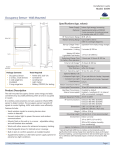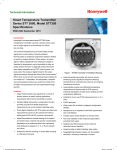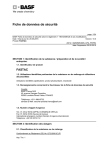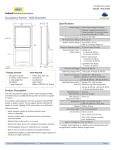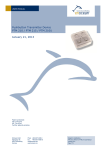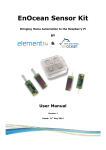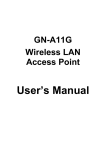Download User manual
Transcript
Installation Guide Model: EDWS Door/Window Sensor 0.5” 12.7mm Solar Panel 0.59” 15mm Specifications Power Supply Transmission Range RF Communications Link Button Charge Time before Linking Alignment Arrow (Sensor) Alignment Arrow (Magnet) 3.15” 80mm Charge Time for Full Charge LED Display Operating Life in Darkness (after full charge) 0.83” 21mm Package Contents ▪▪ Sensor and magnet ▪▪ 4 screws Light Required to Sustain Operation 0.47” 12mm EEP (EnOcean Equipment Profile) Maximum Sensor Gap Indoor light energy harvesting (Optional) Supplemental battery 80 ft. (25 m) EnOcean 902MHz (EDWSU) 2.7 hours @ 10 lux 3.7 minutes @ 200 lux 15 lux for 6 actuations/hour 50 lux for 30 actuations/hour 100 lux for 60 actuations/hour 21 hours @ 200 lux (after startup) 42 hours @ 200 lux (cold start) 174 hours: heartbeat only 67 hours @ 10 actuations/hour 10 hours @ 100 actuations/hour D5-00-01 0.25 inch (6.4 mm) Dimensions (Sensor) 3.15” L x 0.83” W x 0.59” D (80 mm x 21 mm x 15 mm) Tools Required Dimensions (Magnet) ▪▪ Screwdriver ▪▪ Leveling tool ▪▪ Light meter 3.15” L x 0.47” W x 0.5” D (80 mm x 12 mm x 13 mm) Weight (Total) Product Description The Door/Window Sensor helps provide energy savings for an area by detecting when a door or window opens or closes. It is a wireless solar-powered sensor that can be used on its own to detect the open and closed status of entry doors or windows, or it can be linked with occupancy sensors to more accurately track when a room is occupied or vacant. The sensor is easy to install on door and window frames, and virtually anything indoors that opens and closes. Features Include: ▪▪ Sends wireless message to other devices whenever a door or window opens or closes ▪▪ Harvests ambient solar energy to power the sensor and send wireless communication ▪▪ Mounts easily on standard doors or windows ▪▪ Works with motion sensors to track room occupancy ▪▪ Supplemental battery option for extreme low-light condi- Environment Agency Compliance 0.97 oz. (27.5 g) • Indoor use only • 32° to 131° F (0° to 55° C) • 5% to 95% relative humidity (non-condensing) FCC, IC Planning Take a moment to plan for the sensor’s successful operation and optimal communication with other system components. Remove the sensor from its packaging and place it under a strong light to charge it for installation. ▪▪ Ensure the location provides consistent and adequate light ▪▪ Install according to the alignment requirements ▪▪ Determine which sensor profile is appropriate (when linking with EnOcean-based In-line Switch, Plug-in Switch or HVAC Setback Modules (refer to the “Linking” and “Sensor Profiles” sections) - otherwise; when linking with 3rd party controllers, these profiles aren’t relevant Consider the construction materials, such as metal and concrete, in the space and obstacles that may interfere with RF signals tions © 2015 EnOcean GmbH Page 1 Door/Window Sensor • Installation Guide Alignment Requirements The proximity of the magnet to the sensor is important for proper detection. The alignment arrows on the sensor and the magnet must point to each other and the gap between them must not exceed .25 inch (6.4mm) in any direction. B. Position the mounting bracket and mark the two mounting screw drill points. C. Insert the first screw loosely and level the mounting bracket. Notches Alignment Guidelines Front View End View gap is 1/4” (6.4mm) or less D. Install the second screw, and then hand-tighten the first screw. E. Snap the sensor onto the mounting bracket where the notches are located. misaligned arrows gap is too wide Tab lock F. Slide the sensor on the bracket until it snaps into place on the tab lock. Installing estimated time: 20 minutes 1. Based on your requirements, decide where you want to install the sensor and the magnet. For door installations, locate the sensor: 4. Install the magnet on the moving part of the door or window. A. Use a screwdriver to press the tab lock and flex the magnet cover to remove it. • On the knob side of the door jamb, away from hinges. • At least 1 ft. (30 cm) above the floor to avoid damage. For window installations, make sure the location does not expose the sensor to contact with water. Tab lock 2. Follow the alignment requirements that are described in the Planning section. NOTE: For easy access and handling, it is recommends that the sensor be linked to a transceiver before installing it, see the Linking section. The cover is removed from the magnet body. 3. Install the sensor on the interior side of the fixed frame. A. Remove the mounting bracket from the sensor. Tab lock Notch © 2015 EnOcean GmbH Page 2 Door/Window Sensor • Installation Guide The two mounting holes are exposed. The Door/Window Sensor is a Transmit-only Device. To link the Door/Window Sensor to a transceiver; the transceiver must first be powered, within wireless range, and set to accepts links. Cover Mounting Holes B. Position the magnet with the proper spacing and alignment, and then install it with the provided screws. Next, the desired transmitter, or another transceiver, is triggered to send a special link message. The awaiting transceiver receives and stores the link permanently so the devices can interact to provide a variety of intelligent control options. Sensor Profiles The sensor profile determines how the sensor is used within the system, whether it is for occupancy detection, HVAC control, or single load control. How the sensor interacts with other devices depends on where it is installed and how it is linked. There are three sensor profiles. NOTE: These profiles are supported for linking with EnOcean EISM (In-line Switch), EPSM (Plug-in Switch), and EHSM (HVAC Setback) controllers. Consult the manual for the respective controllers to determine the capabilities of the solution. Entry Door - for Occupancy Detection C. Replace the magnet cover and snap it into place on the tab lock. Fixed Frame For this profile, the sensor is installed on an entry door and operates with a motion sensor as follows: Door Opens The door/window ajar timer starts. If the timer runs out, shutdown mode is activated on the HVAC system. Moving Part NOTE: For low activity applications, the magnet can be mounted with double-sided tape (not included). 5. Check the alignment arrows and the distance between the sensor and magnet when the door or window is closed. TIP: There is a faintly audible click when the sensor and magnet close and open. ▪▪ Transmit-only: Transmitters are simple energy-harvesting devices that send RF messages to communicate a condition, level, or state. Transmitters can only be linked to transceivers. Examples > Self-powered Light Switches, Occupancy Sensors ▪▪ Transmit & Receive: Transceivers are controlling devices that send as well as receive RF messages. They also process relevant control logic, and actuate the appropriate outputs (switching a light on or off for example). Transceivers can be linked with transmitters as well as other transceivers. A transceiver can have up to 30 devices linked to it. Examples > Relays, Gateways © 2015 EnOcean GmbH The door/window ajar timer is reset if all monitored doors and windows are closed. The vacancy check timer starts, if the motion sensor detects occupancy, normal mode is activated on the HVAC system. Window or Patio Door for HVAC Control For this profile, the sensor is installed on a window or patio door and operates as follows: Window Opens The door/window ajar timer starts. If the timer runs out, shutdown mode is activated on the HVAC system. Linking Two or more EnOcean-based devices can be linked and configured to provide the desired control. There are two basic types of devices in the system; transmitters and transceivers. Door Closes Window Closes The door/window ajar timer is reset if all monitored doors and windows are closed. Normal mode is activated on the HVAC system. Closet Door for Single Load Control For this profile, the sensor is installed on a closet door and operate as follows because it is the only linked device: Door Opens The switched auto-off timer starts and the light turns on. If the timer runs out the light turns off. Door Closes The light turns off. Page 3 Door/Window Sensor • Installation Guide Troubleshooting To Link or Unlink a Sensor When a Door/Window Sensor is linked, the position of the magnet indicates to the transceiver which type of sensor profile is being used. 1. Set the desired transceiver to Accept a Link. Problem A. Entry door for occupancy detection, place the magnet beside the sensor (closed position). C. Closet door for single load control, move the magnet away from the sensor (open position). ▪▪ ▪▪ The linked device does not respond to wireless messages 3. Press the Link button on the sensor once. The Set button on the transceiver will be solid green for 3 seconds. The device is now linked. ▪▪ ▪▪ ▪▪ 2. Do one of the following according to the desired profile: B. Window or patio door for HVAC control, move the magnet way from the sensor (open position). Solution Checklist The sensor does not generate a wireless message ▪▪ ▪▪ ▪▪ ▪▪ Tab lock Notch 902 MHz: Verify there is a faintly audible click when the contact is closed and opened Verify the LED blinks once when the contact is closed and opened Verify the solar cell is charged properly Check that the magnet is oriented to the sensor properly Check that the alignment arrows are not spaced more than .25 inch (6.4 mm) Check for environment or range issues. Tip: Reorienting the sensor may overcome adverse RF conditions Verify the device is linked Check the transceiver connection and the wiring for errors Check if appropriate devices are linked according to good system planning Contains: FCC: SZV-STM320U IC: 5713A-STM320U This device complies with part 15 of the FCC rules and Industry Canada ICES-003. Operation is subject to the following two conditions: (1) This device may not cause harmful interference, and (2) this device must accept any interference received, including interference that may cause undesired operation. IMPORTANT! Any changes or modifications not expressly approved by the party responsible for compliance could void the user’s authority to operate this equipment. Installing Supplemental Battery (optional) If the sensor is installed where the light levels are consistently too low or there are days of darkness, battery power can be used to supplement the solar energy harvester. Only use a CR1216 battery. Le présent appareil est conforme aux CNR d’Industrie Canada applicables aux appareils radio exempts de licence. L’exploitation est autorisée aux deux conditions suivantes: (1) l’appareil ne doit pas produire de brouillage, et (2) l’utilisateur de l’appareil doit accepter tout brouillage radioélectrique subi, meme si le brouillage est susceptible d’en compromettre le fonctionnement. IMPORTANT! Tous les changements ou modifications pas expressément approuvés par la partie responsable de la conformité ont pu vider l’autorité de l’utilisateur pour actioner cet équipment. 1. Press the tab lock to release the sensor from the mounting bracket. 2. Slide the sensor about ½” (1 cm) and remove it from the mounting plate. 3. Insert the battery with the positive pole (+) up and slide it between the two contact terminals with your finger. NOTE: It is strongly recommended to wear protective gloves while handling coin cell batteries. Failure to do so might result in the formation of a conductive layer on the battery surface due to skin moisture and a much shorter battery lifetime. WARNING: Ensure the battery is properly oriented. Improper handling of lithium batteries may result in heat generation, explosion, or fire. 4. Replace the sensor on the mounting plate and slide it until it snaps into place. 5. Open and close the contact to test for power. 6. There should be a faintly audible click and a fast LED blink. © 2015 EnOcean GmbH Page 4 V1.6 XDWSIGEO




